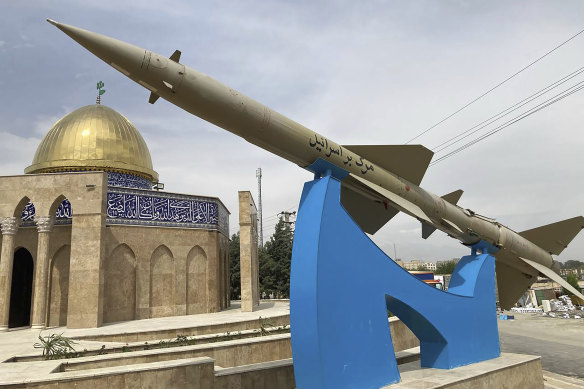This was published 3 months ago
Opinion
Iran’s show of force has demonstrated that Israel is not invincible
Amin Saikal
Professor of Middle Eastern, Central Asian and Islamic StudiesThe Israeli and Iranian direct military exchanges have left the Middle East in a state of suspense, as surrounding nations wait to see what will happen next.
The Israeli attack on the Iranian consulate in Damascus on April 1, Iran’s retaliation and Israel’s counter-response, for now, have amounted to a show of force between the two foes rather than an opening gambit for a wider conflict.
The Iranian attack was very measured and limited in impact. It was telegraphed well in advance and aimed mainly at two airbases near Israel’s nuclear facilities. Only seven out of more than 300 Iranian drones and missiles hit their targets, causing little damage and minor injuries to a few dozen Israelis. The other 293 were shot down with instrumental assistance from American, British, French and Jordanian forces.
The aim of both sides was not to escalate their respective attacks into an all-out war, but to highlight their statuses. For years, the two nations have been engaged in a shadowy war of indirect conflicts that allow them to flex their power in the region and to international allies, but in a way that also acts as a deterrence and prevents a direct clash.
But this month’s exchanges have brought one benefit: the two countries learnt a great deal about each other’s capabilities, and the level of damage possible if they were to enter a wider conflict.
Another reality revealed was that Israel may not have been able to defend itself against the air assault as successfully as it did if it were acting alone. Had it not been for allied help, many more projectiles may have broken through and caused greater damage to the country.
From Tehran’s perspective, its operation sent a message that Israel was not as invincible and impenetrable as it had been made out to be, and that in the event of a wider conflict, Iran could directly and with its regional affiliates – Lebanese Hezbollah, the Syrian regime, Iraqi militias and Yemeni Houthis – overwhelm Israeli defences. The strikes have also signalled to Israel’s international backers, the US in particular, that Iran is not a paper tiger – it is capable of causing a lot more damage not only to Israel, but also to the interests of Israel’s allies in the region.
Further, Tehran could draw satisfaction not just from US declarations that it would refuse to be a party to any war with Iran, but also that several pro-US Arab states in the Gulf – led by Saudi Arabia and the United Arab Emirates – would deny the US access to their territories for any operation against Iran.
Beyond this, the Iranian retaliation enabled the country’s Islamic regime to indicate that despite facing considerable opposition at home, it is still sufficiently powerful and resilient to be robust in its defence internally and externally.
In many ways, Israel has mirrored the Iranian position. Its attack on an airbase in Isfahan that houses Iranian nuclear facilities was limited in scope and impact. It was designed to send a strong message that Iran’s most secure military sites were within Israel’s reach and vulnerable to its power, and that should Tehran escalate, Israel (the only nuclear-armed state in the Middle East) can exact a heavy toll on it.
Further, besieged Prime Minister Benjamin Netanyahu wanted to demonstrate to the Israeli public and beyond that despite being bogged down in Gaza and unable to neutralise Iranian proxies in the region, none of the Arab states, several of which have normalised relations with Israel, actively endorsed or backed the Iranian operation.

A missile is on display with a sign on it reading in Farsi: “Death to Israel” in front of a mosque in the shape of Dome of the Rock of Jerusalem at an entrance of the Quds town west of the capital Tehran, Iran.Credit: AP
For the time being, these tit-for-tat operations have resulted in a stalemate, with each side having achieved a degree of face-saving to play down the prospects of a broader conflict. It seems both sides have tested their capabilities and vulnerabilities to a point that for now, they may be deterred from engaging in a much-feared war.
But this lull does not necessarily spell the end of this long-running shadowy war. To the contrary, Israel’s Isfahan attack was followed by a huge explosion in an Iranian-backed Popular Mobilisation Forces base in Iraq, killing a pro-Iranian militia and injuring seven. The US has denied any involvement and Israel has, as usual, said nothing. But US sources have reported Israel to be the perpetrator. Iran can be expected to respond, but as before through one of its regional affiliated forces. Thus, the cycle of hostility between the two nations continues.
While an escalation in conflict between Iran and Israel would be devastating for either nation, in the current environment, one has far more to lose than the other. With both nations putting their cards on the table, the danger of a regional war has diminished. But the potential for it through intentional action or miscalculation still exists in a highly volatile region that has often defied predictions.
Amin Saikal is emeritus professor of Middle Eastern and Central Asian studies at the Australian National University, adjunct professor of social sciences at the University of Western Australia, and author of Iran Rising: the survival and future of the Islamic Republic.
The Opinion newsletter is a weekly wrap of views that will challenge, champion and inform your own. Sign up here.